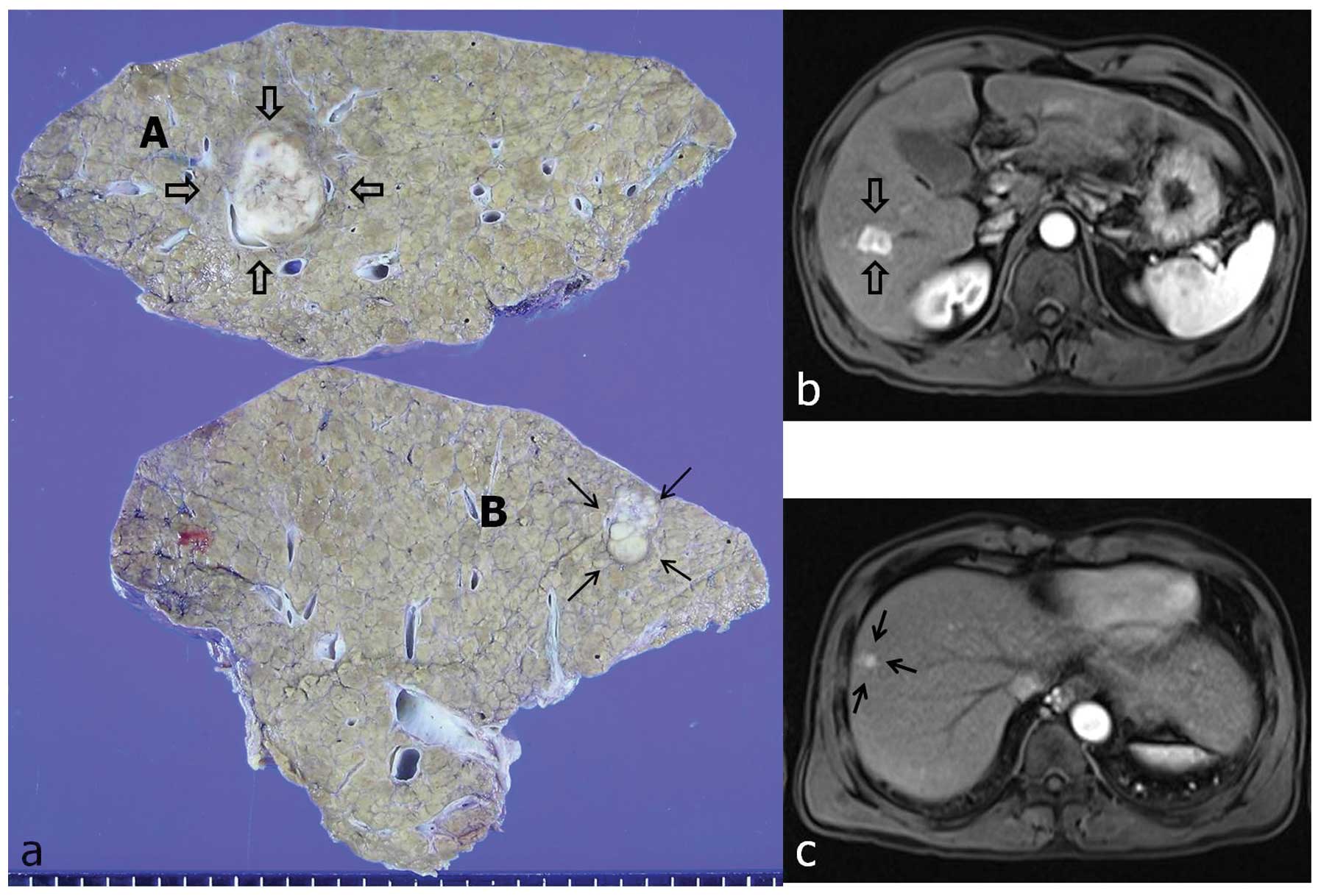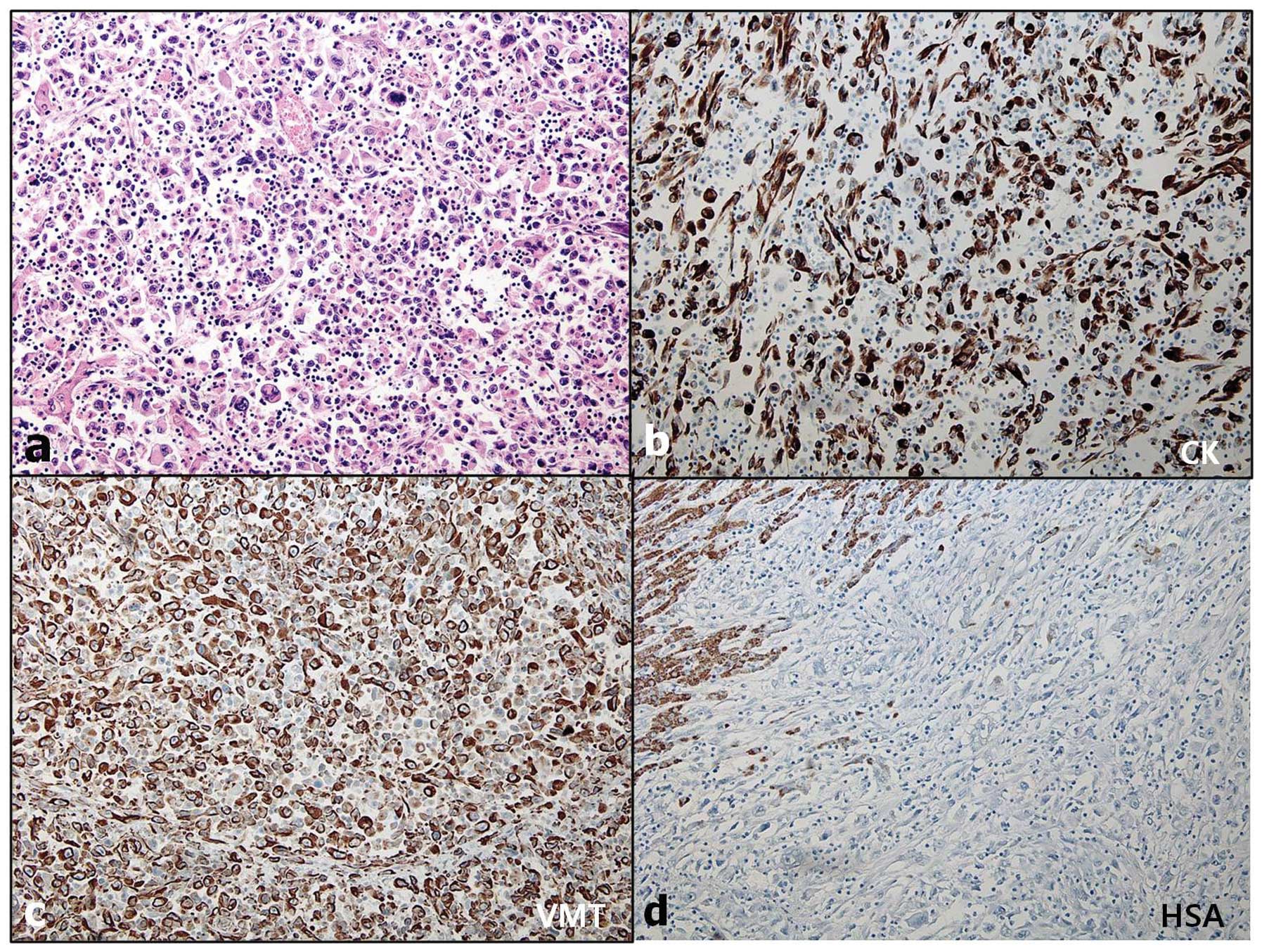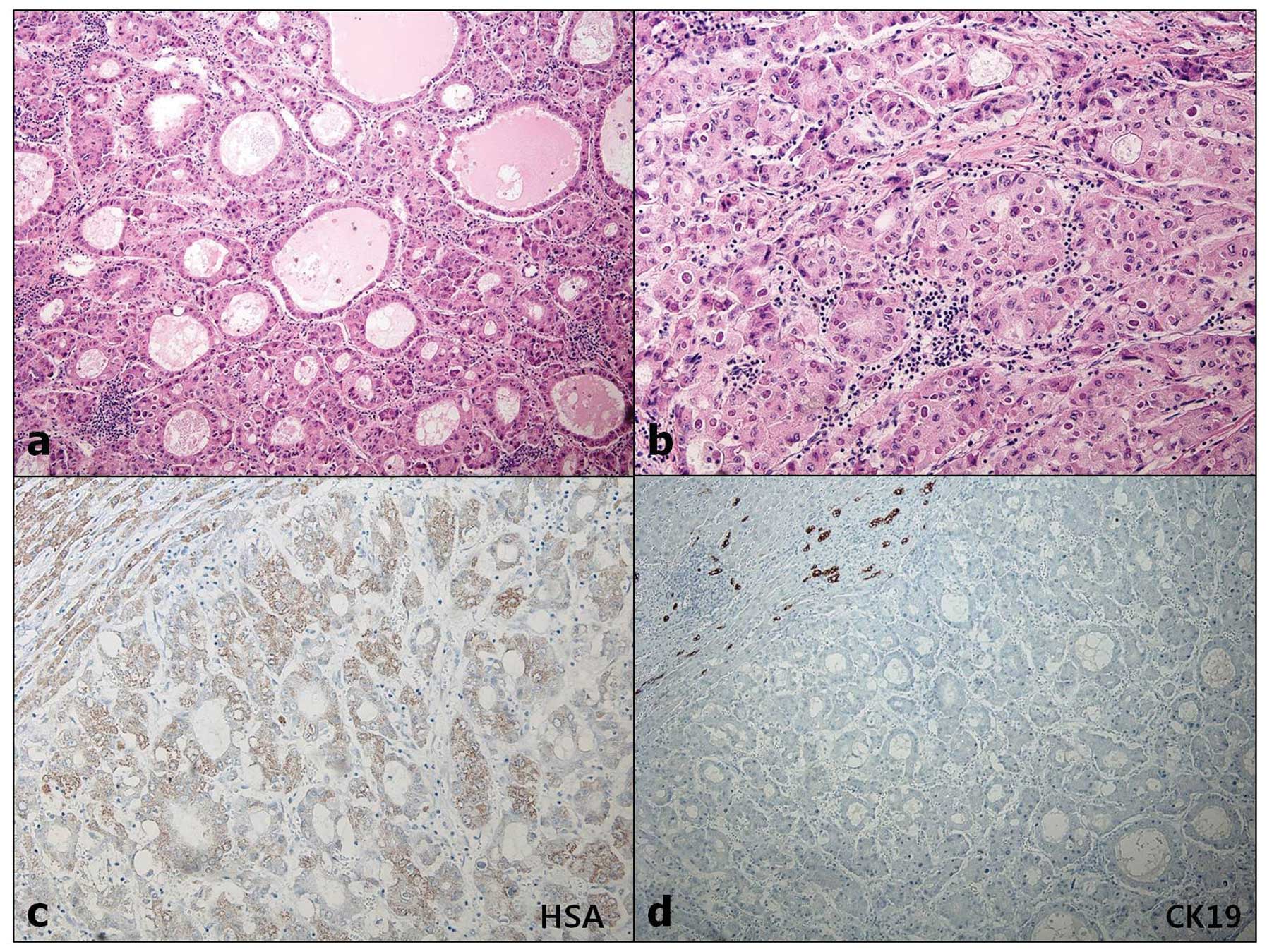Double primary hepatic cancer (sarcomatoid carcinoma and hepatocellular carcinoma): A case report
- Authors:
- Published online on: August 26, 2014 https://doi.org/10.3892/mco.2014.402
- Pages: 949-952
Abstract
Introduction
Primary liver cancer (PLC) is the fifth most common malignancy worldwide (1) and hepatocellular carcinoma (HCC) is the most common histological type of PLC (2). HCC commonly develops in patients with carcinogenetic backgrounds of chronic viral infection, such as hepatitis B virus (HBV) or hepatitis C virus, or alcoholic liver injury. Primary liver sarcomatoid carcinoma (SC) is a rare tumor that may be associated with HCC and cholangiocarcinoma (2). Primary liver SC may also arise as a pure sarcomatous carcinoma, which is associated with a poor prognosis due to rapid growth and high recurrence rate following resection (3). This is the case report of a patient with combined HCC and primary liver SC, in a background of HBV chronic viral hepatitis with cirrhosis and alcoholic liver injury. To the best of our knowledge, this is the first case report of combined HCC and primary liver SC.
Case report
A 54-year-old man, who had been routinely checked for chronic hepatitis associated with HBV infection, liver cirhosis and alcoholic liver injury, complained of fatigue and general weakness. The biochemical indices of liver function were unremarkable. Abdominal ultrasonography revealed mild hepatic shrinkage and coarse nodular echoes. There was a small enhancing nodule in S5–S6 and a small hypoechoic nodule in the right lobe of the liver. Abdominal computed tomography (CT) and magnetic resonance imaging (MRI) revealed two masses in the right robe of the liver, one in S5–S6, sized 2 cm (Fig. 1b) and the other in S8, sized 1.3 cm (Fig. 1c). Right lobectomy was performed upon a clinical diagnosis of double HCC. Grossly, the surgical specimen displayed two distinct masses, in a background of typical multinodular cirrhotic changes. The larger mass was well-demarcated, measuring 2.5×2.0 cm, of gray to white color and exhibiting central hemorrhage (Fig. 1a, labeled as ‘A’). Microscopically, the tumor was composed of pleomorphic cells of round to oval and spindle shape, haphazardly arranged, with frequent atypical mitotic figures. The microscopic characteristics were not suggestive of HCC (Fig. 2a). The tumor cells were immunoreactive for cytokeratin (CK) (Fig. 2b) and vimentin (VMT) (Fig. 2c), but negative for hepatocyte-specific antigen (HSA) (Fig. 2d), CK19, CK20 and CD68. The other mass was a white to gray nodule, sized 1.3×1.0 cm, with small satellite lesions (Fig. 1a, labeled as ‘B’). Microscopically, variable characteristics of HCC were observed, with a pseudoglandular and trabecular appearance (Fig. 3a and b). The tumor cells were positive for HSA (Fig. 3c) and CK, but negative for CK7, CK19 and VMT (Fig. 3d). There was no transition or intermingling of cells between the two tumors. The final diagnosis was double primary tumor of the liver (primary liver SC and HCC). At 4 months after resection, the patient developed uncontrolled ascites and succumbed to peritoneal cancer seeding.
Discussion
Primary liver SC and carcinosarcoma (CS) of the liver comprise a mixture of carcinomatous and sarcomatous elements and are very rare worldwide, with only a few such cases reported in the English literature (4). CS is defined by the World Health Organization (WHO) as a malignant tumor that consists of an intimate mixture of carcinomatous (either HCC or cholangiocellular carcinoma) and sarcomatous elements (5). If the sarcomatous areas with malignant epithelial components were composed of variable malignant mesenchymal components, the tumor would be considered to be a CS. However, if the sarcomatous areas were composed of only malignant spindle cells and were shown to display epithelial characteristics based on immunohistochemical and electron microscopic findings, the tumor would be diagnosed as SC or spindle cell carcinoma (6). The sarcomatous elements of CS lack epithelial markers and the tumor is considered a true heterogonous sarcoma, whereas the sarcomatous element of SC retains the expression of epithelial markers (4). In the present case, the morphological characteristics of the tumor were similar to those of undifferentiated sarcoma. The microscopic examination of hematoxylin-eosin stained specimens revealed a diffuse proliferation of atypical and pleomorphic spindle cells with hyperchromatic nuclei, high nuclear-to-cytoplasmic ratio and poor cellular adhesion. Frequent atypical mitotic figures were also identified. Immunohistochemically, the tumor cells were immunoreactive for epithelial markers (CK).
The pathogenesis of the sarcomatoid component in primary SC and CS of the liver remains unclear. Therefore, knowledge of the histogenesis of sarcomatoid transformation in liver cancer is crucial (4). Murata et al (7) reported that genetic and immunohistochemical analyses support the hypothesis that undifferentiated, sarcomatoid HCC and cholangiocarcinoma may be derived from an original HCC, while Fayyazi et al hypothesized that this tumor arises from totipotent stem cells that are able to differentiate into both epithelial and mesenchymal cells (8), and other researchers suggested that the carcinomatous components were likely to transform into sarcomatous components through a metaplastic process (9,10). Certain authors reported that the neoplastic cells of conventional HCC may be capable of transforming into multipotent immature cells, which, in turn, redifferentiate into sarcomatous components (9,11–14). In addition, the WHO tumor classification (4th edition) suggests that the sarcomatoid component represents clonal evolution from a differentiated component (HCC or cholangiocarcinoma) (15).
In addition to SC, there was another tumor in this patient, which was diagnosed as HCC with a pseudoglandular and trabecular pattern. To the best of our knowledge, this is the first case report of synchronous development of hepatic SC and HCC, whereas on preoperative radiological studies (abdominal ultrasound, CT and MRI) these two masses were considered to be HCCs, due to their similar imaging characteristics.
We reported a case of synchronously detected primary liver SC and HCC in a background of HBV chronic viral hepatitis with cirrhosis and alcoholic liver injury. In conclusion, as primary liver SC is an aggressive tumor with a high recurrence rate and a tendency for rapid growth, accurate and prompt diagnosis through thorough tissue sampling and intensive immunohistochemical analysis is crucial.
Acknowledgements
This study was supported by research funds from the Chosun University, Republic of Korea, 2013.
References
|
Cao J, Huang L, Liu C, et al: Double primary hepatic cancer (hepatocellular carcinoma and intrahepatic cholangiocarcinoma) in a single patient: a clinicopathologic study of 35 resected cases. J Gastroenterol Hepatol. 28:1025–1031. 2013. View Article : Google Scholar | |
|
Uemoto J, Hoshi N, Hirabayashi K, et al: Collision tumors of hepatocellular carcinoma and malignant peritoneal mesothelioma. Med Mol Morphol. 46:177–183. 2013. View Article : Google Scholar : PubMed/NCBI | |
|
Yokomizo J, Cho A, Yamamoto H, et al: Sarcomatous hepatocellular carcinoma without previous anticancer therapy. J Hepatobiliary Pancreat Surg. 14:324–327. 2007. View Article : Google Scholar : PubMed/NCBI | |
|
Wang QB, Cui BK, Weng JM, Wu QL, Qiu JL and Lin X: Clinicopathological characteristics and outcome of primary sarcomatoid carcinoma and carcinosarcoma of the liver. J Gastrointest Surg. 16:1715–1726. 2012. View Article : Google Scholar : PubMed/NCBI | |
|
Nomura K, Aizawa S and Ushigome S: Carcinosarcoma of the liver. Arch Pathol Lab Med. 124:888–890. 2000.PubMed/NCBI | |
|
Kwon JH, Kang YN and Kang KJ: Carcinosarcoma of the liver: a case report. Korean J Radiol. 8:343–347. 2007. View Article : Google Scholar : PubMed/NCBI | |
|
Murata M, Miyoshi Y, Iwao K, et al: Combined hepatocellular/cholangiocellular carcinoma with sarcomatoid features: genetic analysis for histogenesis. Hepatol Res. 21:220–227. 2001. View Article : Google Scholar | |
|
Fayyazi A, Nolte W, Oestmann JW, Sattler B, Ramadori G and Radzun HJ: Carcinosarcoma of the liver. Histopatholology. 32:385–387. 1998. View Article : Google Scholar | |
|
Kubosawa H, Ishige H, Kondo Y, Konno A, Yamamoto T and Nagao K: Hepatocellular carcinoma with rhabdomyoblastic differentiation. Cancer. 62:781–786. 1988. View Article : Google Scholar | |
|
Rosai J: Rosai and Ackerman’s Surgical Pathology. 9th edition. Mosby; Edinburgh: pp. 2592004 | |
|
Lao XM, Chen DY, Zhang YQ, Xiang J, Guo RP, Lin XJ and Li JQ: Primary carcinosarcoma of the liver: clinicopathologic features of 5 cases and a review of the literature. Am J Surg Pathol. 31:817–826. 2007. View Article : Google Scholar : PubMed/NCBI | |
|
Maeda T, Adachi E, Kajiyama K, Takenaka K, Sugimachi K and Tsuneyoshi M: Spindle cell hepatocellular carcinoma. A clinicopathologic and immunohistochemical analysis of 15 cases. Cancer. 77:51–57. 1996. View Article : Google Scholar : PubMed/NCBI | |
|
Wick MR and Swanson PE: Carcinosarcomas: current perspectives and an historical review of nosological concepts. Semin Diagn Pathol. 10:118–127. 1993.PubMed/NCBI | |
|
Nakajima T, Kubosawa H, Kondo Y, Konno A and Iwama S: Combined hepatocellular-cholangiocarcinoma with variable sarcomatous transformation. Am J Clin Pathol. 90:309–312. 1998.PubMed/NCBI | |
|
Miettinen M, Fletcher CDM, Kindblom LG, Zimmermann A and Tsui WMS: Mesenchymal tumours of the liver. World Health Organization Classification of Tumours of the Digestive System. Bosman FT, carneiro F, Hruban RH, Theise ND, Fred T and Bosman: 4th edition. IARC Press; Lyon: pp. 2492010 |












